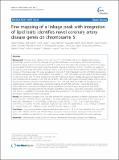Files in this item
Fine mapping of a linkage peak with integration of lipid traits identifies novel coronary artery disease genes on chromosome 5
Item metadata
| dc.contributor.author | Nolan, Daniel K. | |
| dc.contributor.author | Sutton, Beth | |
| dc.contributor.author | Haynes, Carol | |
| dc.contributor.author | Johnson, Jessica | |
| dc.contributor.author | Sebek, Jacqueline | |
| dc.contributor.author | Dowdy, Elaine | |
| dc.contributor.author | Crosslin, David | |
| dc.contributor.author | Crossman, David | |
| dc.contributor.author | Sketch, Michael H. | |
| dc.contributor.author | Granger, Christopher B. | |
| dc.contributor.author | Seo, David | |
| dc.contributor.author | Goldschmidt-Clermont, Pascal | |
| dc.contributor.author | Kraus, William E. | |
| dc.contributor.author | Gregory, Simon G. | |
| dc.contributor.author | Hauser, Elizabeth R. | |
| dc.contributor.author | Shah, Svati H. | |
| dc.date.accessioned | 2018-10-17T14:30:17Z | |
| dc.date.available | 2018-10-17T14:30:17Z | |
| dc.date.issued | 2012-02-27 | |
| dc.identifier | 256234027 | |
| dc.identifier | abcf66af-2cb8-495b-8698-40a9b8fa915f | |
| dc.identifier | 84857410607 | |
| dc.identifier | 22369142 | |
| dc.identifier.citation | Nolan , D K , Sutton , B , Haynes , C , Johnson , J , Sebek , J , Dowdy , E , Crosslin , D , Crossman , D , Sketch , M H , Granger , C B , Seo , D , Goldschmidt-Clermont , P , Kraus , W E , Gregory , S G , Hauser , E R & Shah , S H 2012 , ' Fine mapping of a linkage peak with integration of lipid traits identifies novel coronary artery disease genes on chromosome 5 ' , BMC Genetics , vol. 13 , 12 . https://doi.org/10.1186/1471-2156-13-12 | en |
| dc.identifier.issn | 1471-2156 | |
| dc.identifier.other | ORCID: /0000-0003-4762-8623/work/60196622 | |
| dc.identifier.uri | https://hdl.handle.net/10023/16264 | |
| dc.description | This work was supported by R01HL095987-01 (Shah), P01 HL73042 (Kraus, Goldschmidt-Clermont), RC2-HL101612 (Kraus), R01HL073389-01 (Hauser), the American Heart Association (FTF award, Shah), and a genotyping award through the National Heart Lung and Blood Institute (NHLBI) funded Seattle SNPs project (http://pga.gs.washington.edu). | en |
| dc.description.abstract | Background: Coronary artery disease (CAD), and one of its intermediate risk factors, dyslipidemia, possess a demonstrable genetic component, although the genetic architecture is incompletely defined. We previously reported a linkage peak on chromosome 5q31-33 for early-onset CAD where the strength of evidence for linkage was increased in families with higher mean low density lipoprotein-cholesterol (LDL-C). Therefore, we sought to fine-map the peak using association mapping of LDL-C as an intermediate disease-related trait to further define the etiology of this linkage peak. The study populations consisted of 1908 individuals from the CATHGEN biorepository of patients undergoing cardiac catheterization; 254 families (N = 827 individuals) from the GENECARD familial study of early-onset CAD; and 162 aorta samples harvested from deceased donors. Linkage disequilibrium-tagged SNPs were selected with an average of one SNP per 20 kb for 126.6-160.2 MB (region of highest linkage) and less dense spacing (one SNP per 50 kb) for the flanking regions (117.7-126.6 and 160.2-167.5 MB) and genotyped on all samples using a custom Illumina array. Association analysis of each SNP with LDL-C was performed using multivariable linear regression (CATHGEN) and the quantitative trait transmission disequilibrium test (QTDT; GENECARD). SNPs associated with the intermediate quantitative trait, LDL-C, were then assessed for association with CAD (i.e., a qualitative phenotype) using linkage and association in the presence of linkage (APL; GENECARD) and logistic regression (CATHGEN and aortas).Results: We identified four genes with SNPs that showed the strongest and most consistent associations with LDL-C and CAD: EBF1, PPP2R2B, SPOCK1, and PRELID2. The most significant results for association of SNPs with LDL-C were: EBF1, rs6865969, p = 0.01; PPP2R2B, rs2125443, p = 0.005; SPOCK1, rs17600115, p = 0.003; and PRELID2, rs10074645, p = 0.0002). The most significant results for CAD were EBF1, rs6865969, p = 0.007; PPP2R2B, rs7736604, p = 0.0003; SPOCK1, rs17170899, p = 0.004; and PRELID2, rs7713855, p = 0.003.Conclusion: Using an intermediate disease-related quantitative trait of LDL-C we have identified four novel CAD genes, EBF1, PRELID2, SPOCK1, and PPP2R2B. These four genes should be further examined in future functional studies as candidate susceptibility loci for cardiovascular disease mediated through LDL-cholesterol pathways. | |
| dc.format.extent | 899651 | |
| dc.language.iso | eng | |
| dc.relation.ispartof | BMC Genetics | en |
| dc.subject | Cardiovascular disease | en |
| dc.subject | Fine mapping | en |
| dc.subject | Intermediate phenotype | en |
| dc.subject | Linkage | en |
| dc.subject | Positional cloning | en |
| dc.subject | QH426 Genetics | en |
| dc.subject | Genetics | en |
| dc.subject | Genetics(clinical) | en |
| dc.subject | SDG 3 - Good Health and Well-being | en |
| dc.subject.lcc | QH426 | en |
| dc.title | Fine mapping of a linkage peak with integration of lipid traits identifies novel coronary artery disease genes on chromosome 5 | en |
| dc.type | Journal article | en |
| dc.contributor.institution | University of St Andrews. School of Medicine | en |
| dc.contributor.institution | University of St Andrews. Office of the Principal | en |
| dc.identifier.doi | 10.1186/1471-2156-13-12 | |
| dc.description.status | Peer reviewed | en |
| dc.identifier.url | http://www.scopus.com/inward/record.url?scp=84857410607&partnerID=8YFLogxK | en |
This item appears in the following Collection(s)
Items in the St Andrews Research Repository are protected by copyright, with all rights reserved, unless otherwise indicated.

